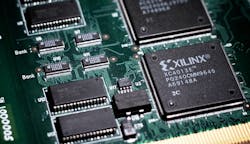Xilinx, the maker of field programmable gate arrays, recently chose chief operating officer Victor Peng to be its chief executive. He will fill the position being vacated by Moshe Gavrielov, who intends to step down at the end of the month.
Peng has been in line for the position since he was promoted last year as part of the succession plan for Gavrielov, who has been chief executive since 2008. The other candidate was Krishna Rangasayee, executive vice president of global sales for Xilinx, but he recently departed to become chief operating officer of Groq, a secretive semiconductor startup.
The changing of the guard underlines other changes for Xilinx, which typically sells chips for industrial, medical, and aerospace applications. The company has started to compete in the market for artificial intelligence because its chips can accelerate trained algorithms by splitting them into small pieces and then processing them in parallel.
Last year, Amazon stocked its cloud data centers with Xilinx’s chips, which can be updated by reprogramming the interconnects inside them. To supplement servers accelerated with graphics chips sold by Nvidia, Baidu followed suit. Microsoft has customized chips sold by Xilinx’s rival Altera, which Intel acquired for $16.7 billion in 2015.
These companies gravitate toward these chips because it is possible to write algorithms directly into the hardware, allowing them to respond quickly to artificial intelligence advances. Microsoft uses them to accelerate algorithms used by its internet search engine. It has crafted a new acceleration fabric to work with them.
For all the new opportunities, Xilinx is facing other challenges. The semiconductor industry has struggled to maintain its pace of doubling transistor density every two years, calling the end of Moore’s Law into question. For years, Xilinx had taken advantage of these manufacturing improvements to stifle startups with new takes on the FPGA.
Xilinx has adjusted its strategy. In his previous role as Xilinx's executive vice president of products, Peng was in charge of the marketing and development of three new generations of the company's chips. But he also supervised Xilinx's push to create new types of interconnects as well as offer customers new programming and integration tools.
Peng joined Xilinx in 2008 after serving as vice president of the graphics products group for Advanced Micro Devices. “He has been the architect of Xilinx’s innovations for the past decade and will move the company forward with the speed required to capitalize on the opportunities in front of us,” said Dennis Segers, Xilinx’s chairman, in a statement.
Last year, Xilinx moved to distinguish itself from rivals, releasing software libraries to aid engineers using its hardware for accelerated computing in data centers. The company said that the Reconfigurable Acceleration Stack would vastly increase the power efficiency of its products used for computer vision and the inferencing phase of deep learning.
In September, Xilinx announced that it would build the first chip to support a standard called the Cache Coherent Interconnect for Accelerators (CCIX), a new type of fabric for connecting computer processors with hardware accelerators like FPGAs. It is working with ARM and TSMC on the silicon, which will be released in 2018.
Xilinx’s stock has increased from $59.05 to $74.15 over the last year. In October, the company announced sales of $620 million in the second quarter, up 7% over the same span last year. Later this month, Xilinx expects to report revenues of between $615 and $645 million for the third quarter, up from $586 million in the same quarter last year.
About the Author
James Morra
Senior Editor
James Morra is the senior editor for Electronic Design, covering the semiconductor industry and new technology trends, with a focus on power electronics and power management. He also reports on the business behind electrical engineering, including the electronics supply chain. He joined Electronic Design in 2015 and is based in Chicago, Illinois.

